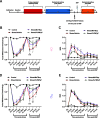Peroxynitrite Contributes to Behavioral Responses, Increased Trigeminal Excitability, and Changes in Mitochondrial Function in a Preclinical Model of Migraine
- PMID: 36697259
- PMCID: PMC10008057
- DOI: 10.1523/JNEUROSCI.1366-22.2023
Peroxynitrite Contributes to Behavioral Responses, Increased Trigeminal Excitability, and Changes in Mitochondrial Function in a Preclinical Model of Migraine
Abstract
Administration of a nitric oxide (NO) donor triggers migraine attacks, but the mechanisms by which this occurs are unknown. Reactive nitroxidative species, including NO and peroxynitrite (PN), have been implicated in nociceptive sensitization, and neutralizing PN is antinociceptive. We determined whether PN contributes to nociceptive responses in two distinct models of migraine headache. Female and male mice were subjected to 3 consecutive days of restraint stress or to dural stimulation with the proinflammatory cytokine interleukin-6. Following resolution of the initial poststimulus behavioral responses, animals were tested for hyperalgesic priming using a normally non-noxious dose of the NO donor sodium nitroprusside (SNP) or dural pH 7.0, respectively. We measured periorbital von Frey and grimace responses in both models and measured stress-induced changes in 3-nitrotyrosine (3-NT) expression (a marker for PN activity) and trigeminal ganglia (TGs) mitochondrial function. Additionally, we recorded the neuronal activity of TGs in response to the PN generator SIN-1 [5-amino-3-(4-morpholinyl)-1,2,3-oxadiazolium chloride]. We then tested the effects of the PN decomposition catalysts Fe(III)5,10,15,20-tetrakis(N-methylpyridinium-4-yl) porphyrin (FeTMPyP) and FeTPPS [Fe(III)5,10,15,20-tetrakis(4-sulfonatophenyl)porphyrinato chloride], or the PN scavenger MnTBAP [Mn(III)tetrakis(4-benzoic acid)porphyrin] against these behavioral, molecular, and neuronal changes. Neutralizing PN attenuated stress-induced periorbital hypersensitivity and priming to SNP, with no effect on priming to dural pH 7.0. These compounds also prevented stress-induced increases in 3-NT expression in both the TGs and dura mater, and attenuated TG neuronal hyperexcitability caused by SIN-1. Surprisingly, FeTMPyP attenuated changes in TG mitochondrial function caused by SNP in stressed males only. Together, these data strongly implicate PN in migraine mechanisms and highlight the therapeutic potential of targeting PN.SIGNIFICANCE STATEMENT Among the most reliable experimental triggers of migraine are nitric oxide donors. The mechanisms by which nitric oxide triggers attacks are unclear but may be because of reactive nitroxidative species such as peroxynitrite. Using mouse models of migraine headache, we show that peroxynitrite-modulating compounds attenuate behavioral, neuronal, and molecular changes caused by repeated stress and nitric oxide donors (two of the most common triggers of migraine in humans). Additionally, our results show a sex-specific regulation of mitochondrial function by peroxynitrite following stress, providing novel insight into the ways in which peroxynitrite may contribute to migraine-related mechanisms. Critically, our data underscore the potential in targeting peroxynitrite formation as a novel therapeutic for the treatment of migraine headache.
Keywords: dura mater; headache; migraine; nitric oxide; peroxynitrite; trigeminal ganglia.
Copyright © 2023 the authors.
Conflict of interest statement
The authors declare no competing financial interests.
Figures











Similar articles
-
Targeting reactive nitroxidative species in preclinical models of migraine.Cephalalgia. 2021 Oct;41(11-12):1187-1200. doi: 10.1177/03331024211017884. Epub 2021 Jul 13. Cephalalgia. 2021. PMID: 34256650
-
MNK1/2 contributes to periorbital hypersensitivity and hyperalgesic priming in preclinical migraine models.Brain. 2023 Feb 13;146(2):448-454. doi: 10.1093/brain/awac386. Brain. 2023. PMID: 36299248 Free PMC article.
-
Dural Calcitonin Gene-Related Peptide Produces Female-Specific Responses in Rodent Migraine Models.J Neurosci. 2019 May 29;39(22):4323-4331. doi: 10.1523/JNEUROSCI.0364-19.2019. Epub 2019 Apr 8. J Neurosci. 2019. PMID: 30962278 Free PMC article.
-
Methamphetamine-induced dopaminergic neurotoxicity: role of peroxynitrite and neuroprotective role of antioxidants and peroxynitrite decomposition catalysts.Ann N Y Acad Sci. 2001 Jun;939:366-80. doi: 10.1111/j.1749-6632.2001.tb03646.x. Ann N Y Acad Sci. 2001. PMID: 11462792 Review.
-
Reactive nitroxidative species and nociceptive processing: determining the roles for nitric oxide, superoxide, and peroxynitrite in pain.Amino Acids. 2012 Jan;42(1):75-94. doi: 10.1007/s00726-010-0633-0. Epub 2010 Jun 16. Amino Acids. 2012. PMID: 20552384 Review.
Cited by
-
Exploring the efficacy of acupuncture for tension-type headache: a literature review and insights from traditional Chinese medicine.J Oral Facial Pain Headache. 2024 Dec;38(4):11-23. doi: 10.22514/jofph.2024.035. Epub 2024 Dec 12. J Oral Facial Pain Headache. 2024. PMID: 39800952 Free PMC article. Review.
-
Meningeal brain borders and migraine headache genesis.Trends Neurosci. 2024 Nov;47(11):918-932. doi: 10.1016/j.tins.2024.08.012. Epub 2024 Sep 19. Trends Neurosci. 2024. PMID: 39304416 Review.
-
FeTPPS, a Peroxynitrite Decomposition Catalyst, Ameliorates Nitrosative Stress in Human Spermatozoa.Antioxidants (Basel). 2023 Jun 14;12(6):1272. doi: 10.3390/antiox12061272. Antioxidants (Basel). 2023. PMID: 37372002 Free PMC article.
-
In Vitro Pharmacological Modulation of PIEZO1 Channels in Frontal Cortex Neuronal Networks.Brain Sci. 2024 Feb 27;14(3):223. doi: 10.3390/brainsci14030223. Brain Sci. 2024. PMID: 38539612 Free PMC article.
-
Astrocytic Inducible Nitric Oxide Synthase Upregulation Contributes to Chronic Below-Level Neuropathic Pain Following Spinal Cord Injury in Male Rats.Eur J Pain. 2025 Jul;29(6):e70047. doi: 10.1002/ejp.70047. Eur J Pain. 2025. PMID: 40411263 Free PMC article.
References
Publication types
MeSH terms
Substances
Grants and funding
LinkOut - more resources
Full Text Sources
Medical
Research Materials
Miscellaneous
